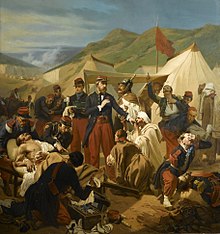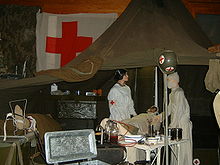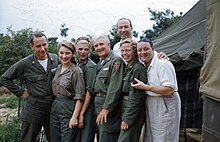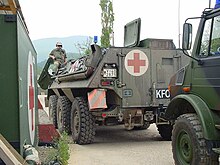












The term military medicine has a number of potential connotations. It may mean:
Military medical personnel engage in humanitarian work and are "protected persons" under international humanitarian law in accordance with the First and Second Geneva Conventions and their Additional Protocols, which established legally binding rules guaranteeing neutrality and protection for wounded soldiers, field or ship's medical personnel, and specific humanitarian institutions in an armed conflict. International humanitarian law makes no distinction between medical personnel who are members of the armed forces (and who hold military ranks) and those who are civilian volunteers. All medical personnel are considered non-combatants under international humanitarian law because of their humanitarian duties, and they may not be attacked and not be taken as prisoners of war; hospitals and other medical facilities and transports identified as such, whether they are military or civilian, may not be attacked either. The red cross, the red crescent and the red crystal are the protective signs recognised under international humanitarian law, and are used by military medical personnel and facilities for this purpose. Attacking military medical personnel, patients in their care, or medical facilities or transports legitimately marked as such is a war crime. Likewise, misusing these protective signs to mask military operations is the war crime of perfidy. Military medical personnel may be armed, usually with service pistols, for the purpose of self defense or the defense of patients.
The significance of military medicine for combat strength goes far beyond treatment of battlefield injuries; in every major war fought until the late 19th century disease claimed more soldier casualties than did enemy action. During the American Civil War (1860–65), for example, about twice as many soldiers died of disease as were killed or mortally wounded in combat.[1] The Franco-Prussian War (1870–71) is considered to have been the first conflict in which combat injury exceeded disease, at least in the German coalition army which lost 3.47% of its average headcount to combat and only 1.82% to disease.[2] In new world countries, such as Australia, New Zealand, the United States and Canada, military physicians and surgeons contributed significantly to the development of civilian health care.[3][4]
Improvements in military medicine have increased the survival rates in successive wars, due to improvements in medical evacuation, battlefield medicine and trauma care.[4][5] Similar improvements have been seen in the trauma practices during the Iraq war.[6] Some military trauma care practices are disseminated by citizen soldiers who return to civilian practice.[4][7][8] One such practice is where major trauma patients are transferred to an operating theater as soon as possible, to stop internal bleeding, increasing the survival rate. Within the United States, the survival rate for gunshot wounds has increased, leading to apparent declines in the gun death rate in states that have stable rates of gunshot hospitalizations.[9][10][11][12]
Phramongkutklao College of Medicine
{{cite web}}: CS1 maint: multiple names: authors list (link)
U.S. military medicine
Australian military medicine
International Magazine for Military Medicine
NATO Centre of Excellence for Military Medicine
|
| |
|---|---|
| |
| People |
|
| Vehicles |
|
| Casualty lifting and movement |
|
| Other |
|
| Related fields |
|
| International |
|
|---|---|
| National |
|